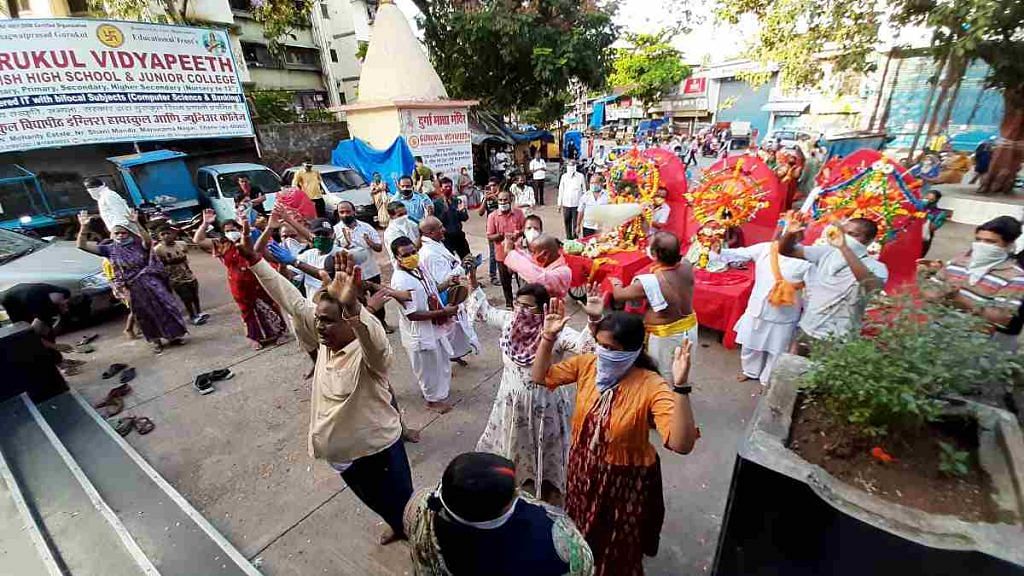Mumbai: Even as Covid-19 cases in Mumbai seem to have plateaued this month, the city’s satellite towns like Navi Mumbai and Thane are seeing a sudden spurt. Struggling against Covid-19 amid a manpower crunch and inadequate healthcare facilities, the civic bodies in all these towns cite a common factor for their predicament — their proximity to Mumbai.
The Mumbai Metropolitan Region (MMR) comprises eight major civic bodies that oversee the municipal limits of Navi Mumbai, Mira-Bhayander, Thane, Bhiwandi-Nizampur, Ulhasnagar, Kalyan Dombivli, and Panvel.
Between 1 June and 23 June, the total number of Covid-19 cases in Mumbai increased by about 70 per cent. In the same period, the total number of Covid-19 cases in the jurisdictions of the eight civic bodies surged by 235 per cent, according to Maharashtra government data. The fatality rate in these areas stood at 3 per cent as of Tuesday, which translates to 810 deaths among the 26,894 cases recorded so far.
Officials from the civic bodies of these towns say cases snowballed after the Uddhav Thackeray-led state government partially relaxed the lockdown with its ‘Mission Begin Again’. The relaxations, which include allowing private offices to open with 10 per cent staff and government offices with 15 per cent, permit travel within the Mumbai Metropolitan Region without requiring a government-approved pass. The relaxations came into effect in phases from 3 June.
Also Read: Dharavi’s unexpected Covid success story has lessons for Delhi, other crowded cities
‘Mumbai contact in most cases’
The towns of Mira Road and Bhayander, which fall under the jurisdiction of the Mira-Bhayander Municipal Corporation, had 699 cases on 1 June, according to state government data. By 23 June, this number had swelled by almost 260 per cent to 2,510.
Chandrakant Dange, who was the civic body’s municipal commissioner until Tuesday when the state government shunted him out, told ThePrint, “Cases started increasing after the lockdown was relaxed on 3 June. Symptoms probably took four to five days to show, and, by 8 June, we started seeing a significant rise in the daily growth of cases. In almost 85-90 per cent of the Covid positive cases, we found there was a Mumbai contact.”
The corporation, Dange added, has started door-to-door surveys for symptoms, ramped up testing to almost 500 per day from about 200-250 earlier, and tapped staff from private schools to manage its manpower shortage.
Besides Dange, the Thackeray-led government also transferred the chiefs of the municipal corporations of Thane, Navi Mumbai and Ulhasnagar after these areas showed a sudden growth in Covid-19 cases in June.
In Navi Mumbai, the number of cases jumped to 5,923 on 23 June from 2,673 on 1 June. In Thane, cases shot up to 7,477 from 3,721 between 1 June and 23 June, while Ulhasnagar witnessed a rise to 1,084 from 331 in the same period.
“A number of drivers, conductors, doctors, nurses, bank employees live in Navi Mumbai and work in Mumbai,” said Jayawant Sutar, Mayor of the Navi Mumbai Municipal Corporation. “Some private offices, too, have started functioning now with limited staff. That increases the risk of the virus spreading in Navi Mumbai.”
According to Sutar, another reason for the high number of cases in Navi Mumbai is that the Agricultural Produce Market Committee mandi at Vashi had been open for almost the entire duration of the lockdown, and traders from Mumbai and the surrounding areas would often travel in and out of Navi Mumbai.
Sandeep Malvi, Deputy Municipal Commissioner and spokesperson at the Thane Municipal Corporation, also attributed the spurt to eased travel within the MMR.
“Travel within the Mumbai Metropolitan Region has eased. There is a lot more contact with Mumbai and other regions. We don’t know where all residents are travelling now,” he said.
“The new cases are mostly from apartments and high rises, whereas we have the situation very much under control in slums,” he said, adding that Thane is doing better than other civic bodies around Mumbai in terms of the number of new cases per day.
Vinita Rane, Mayor, Kalyan Dombivli Municipal Corporation, said, “Cases suddenly shot up after the lockdown was relaxed and local trains to Mumbai for essential service providers were started. We were caught unawares. Now we are clambering to provide for adequate hospital beds. We are commissioning a field hospital, getting oxygen beds, ventilators. We are also taking cots in private hospitals.”
Also Read: How big city Bengaluru managed to beat coronavirus while Mumbai, Delhi, Chennai struggle
Cases in Mumbai may have plateaued
Meanwhile, Mumbai, which has become the centre of the Covid crisis in India, is showing signs that the curve may have flattened.
The doubling rate in the city, which was about 14 days at the beginning of June, is now at 38 days. The doubling rate in Dharavi, the congested slum that was once a Covid hotspot, has improved to 102 days.
On Tuesday, Mumbai reported its lowest single-day growth in cases since 13 May, with 846 new Covid-19 patients.
Municipal Commissioner Iqbal Chahal has gone on the record to say that the Brihanmumbai Municipal Corporation (BMC) will be able to contain the spread of Covid-19 in the city by mid-July.
In a Facebook post Monday, Manisha Mhaiskar, Principal Secretary on deputation to the Brihanmumbai Municipal Corporation and member of the city’s Covid Task Force, said, “Mumbai is sitting on a plateau in June. Daily positives are steady between 1,000 and 1,200, admissions have stabilised. There are vacant beds even in KEM (civic-run King Edward Memorial Hospital). There is no longer a pressure to commission a ward every alternate day.”
This, she said, “is even after two full weeks of unlockdown (sic) in the form of ‘Mission Begin Again’,” she added. Referring to the Mumbai administration’s targeted campaign to trace Covid-19 incidence in the city, she said, “‘Chase the virus’ is working.”
Also Read: How Covid hotspot Dharavi, Asia’s largest slum, fought against all odds to flatten the curve
